Experimental Investigation into the Optimum Position of a Ring Reflector for an Axial Virtual Cathode Oscillator
Abstract
:1. Introduction
2. System Description
2.1. PFN-Marx Generator
2.2. Axial Vircator
2.3. Measurement Equipment
3. PIC Simulation and Experimental Results
3.1. PIC Simulation
3.2. Experimental Results
4. Conclusions
Author Contributions
Funding
Conflicts of Interest
References
- Benford, J.; Swegle, J.A.; Schamiloglu, E. High Power Microwaves, 3rd ed.; CRC Press: Boca Raton, FL, USA, 2015. [Google Scholar]
- Jiang, W.; Kristiansen, M. Theory of the virtual cathode oscillator. Phys. Plasmas 2001, 8, 3781–3787. [Google Scholar] [CrossRef]
- Chen, Y.; Mankowski, J.; Walter, J.; Kristiansen, M. Cathode and Anode Optimization in a Virtual Cathode Oscillator. IEEE Trans. Dielectr. Electr. Insul. 2007, 14, 1037–1044. [Google Scholar] [CrossRef]
- Li, L.; Men, T.; Liu, L.; Wen, J. Dynamics of virtual cathode oscillation analyzed by impedance changes in high-power diodes. J. Appl. Phys. 2007, 102, 123309. [Google Scholar] [CrossRef]
- Kovalchuk, B.M.; Polevin, S.D.; Tsygankov, R.V.; Zherlitsyn, A.A. S-Band Coaxial Vircator With Electron Beam Premodulation Based on Compact Linear Transformer Driver. IEEE Trans. Plasma Sci. 2010, 38, 2819–2824. [Google Scholar] [CrossRef]
- Roy, A.; Sharma, A.; Sharma, V.; Patel, A.; Chakravarthy, D.P. Frequency Variation of a Reflex-Triode Virtual Cathode Oscillator. IEEE Trans. Plasma Sci. 2013, 41, 238–242. [Google Scholar] [CrossRef]
- Guo, L.; Shu, T.; Li, Z.; Ju, J.; Fang, X. Preliminary experimental investigation of an X-Band Cerenkov-type high power microwave oscillator without guiding magnetic field. Rev. Sci. Instrum. 2017, 88, 024708. [Google Scholar]
- Neira, E.; Xie, Y.Z.; Vega, F. On the virtual cathode oscillator’s energy optimization. AIP Adv. 2018, 8, 125210. [Google Scholar] [CrossRef] [Green Version]
- Mumtaz, S.; Lim, J.S.; Ghimire, B.; Lee, S.W.; Choi, J.J.; Choi, E.H. Enhancing the power of high power microwaves by using zone plate and investigations for the position of virtual cathode inside the drift tube. Phys. Plasmas 2018, 25, 103113. [Google Scholar] [CrossRef]
- Parson, J.M.; Lynn, C.F.; Mankowski, J.J.; Kristiansen, M.; Neuber, A.A.; Dickens, J.C. Conditioning of Carbon Fiber Cathodes in UHV-Sealed Tubes at 200 A/cm2. IEEE Trans. Plasma Sci. 2014, 42, 2007–2014. [Google Scholar] [CrossRef]
- Parson, J.M.; Lynn, C.F.; Scott, M.C.; Calico, S.E.; Dickens, J.C.; Neuber, A.A.; Mankowski, J.J. A Frequency Stable Vacuum-Sealed Tube High-Power Microwave Vircator Operated at 500 Hz. IEEE Electron Device Lett. 2015, 36, 508–510. [Google Scholar] [CrossRef]
- Andersson, J.; Jansson, M.; Aberg, D. Frequency Dependence of the Anod-Cathode Gap Spacing in a Coaxial Vircator System. IEEE Trans. Plasma Sci. 2013, 41, 2758–2762. [Google Scholar] [CrossRef]
- Roy, A.; Menon, R.; Mitra, S.; Sharma, A.; Nagesh, K.V.; Chakravarthy, D.P. Influence of Electron-Beam Diode Voltage and Current on Coaxial Vircator. IEEE Trans. Plasma Sci. 2012, 40, 1601–1606. [Google Scholar] [CrossRef]
- Turner, G.R. A one-dimentional model illustrating virtual-cathode formation in a novel coaxial virtual-cathode oscillator. Phys. Plasmas 2014, 21, 093104. [Google Scholar] [CrossRef] [Green Version]
- Jeon, W.; Sung, K.Y.; Lim, J.E.; Song, K.B.; Seo, Y.; Choi, E.H. A Diode Design Study of the Virtual Cathode Oscillator with a Ring-Type Reflector. IEEE Trans. Plasma Sci. 2005, 33, 2011–2016. [Google Scholar] [CrossRef]
- Jeon, W.; Lim, J.E.; Moon, M.W.; Jung, K.B.; Park, W.B.; Shin, H.M.; Seo, Y.; Choi, E.H. Output Characteristics of the High-Power Microwave Generated From a Coaxial Vircator With a Bar Reflector in a Drift Region. IEEE Trans. Plasma Sci. 2006, 34, 937–944. [Google Scholar] [CrossRef]
- Gurnevich, E.; Molchanov, P. The Effect of the Electron-Beam Parameter spread on Microwave Generation in a Three-Cavity Axial Vircator. IEEE Trans. Plasma Sci. 2015, 43, 1014–1017. [Google Scholar] [CrossRef] [Green Version]
- Baryshevsky, V.; Gurinovich, A.; Gurnevich, E.; Molchanov, P. Experimental Study of an Axial Vircator with Resonant Cavity. IEEE Trans. Plasma Sci. 2015, 43, 3507–3511. [Google Scholar] [CrossRef]
- Champeaux, S.; Gouard, P.; Cousin, R.; Larour, J. Improved Design of a Multistage Axial Vircator with Reflectors for Enhanced Performances. IEEE Trans. Plasma Sci. 2016, 44, 31–38. [Google Scholar] [CrossRef]
- Baryshevsky, V.; Gurinovich, A.; Gurnevich, E.; Molchanov, P. Experimental Study of a Triode Reflex Geometry Vircator. IEEE Trans. Plasma Sci. 2017, 45, 631–635. [Google Scholar] [CrossRef] [Green Version]
- Barnett, D.H.; Rainwater, K.; Dickens, J.C.; Neuber, A.A.; Mankowski, J.J. A Reflex Triode System with Multicavity Adjustment. IEEE Trans. Plasma Sci. 2019, 47, 1472–1476. [Google Scholar] [CrossRef]
- Zhang, H.; Shu, T.; Liu, S.; Zhang, Z.; Song, L.; Zhan, H. A Compact Modular 5 GW Pulse PFN-Marx Generatro for Driving HPM Source. Electronics 2021, 10, 545. [Google Scholar] [CrossRef]
- Zhang, H.; Yang, J.; Lin, J.; Yang, X. A compact bipolar pulse-forming network-Marx generator based on pulse transformers. Rev. Sci. Instrum. 2013, 84, 114705. [Google Scholar] [CrossRef] [PubMed]
- Verma, R.; Shukla, R.; Sharma, S.K.; Banerjee, P.; Das, R.; Deb, P.; Prabaharan, T.; Das, B.; Mishra, E.; Adhikary, B.; et al. Characterization of High Power Microwave Radiation by an Axially Extracted Vircator. IEEE Trans. Electron Devices 2014, 61, 141–146. [Google Scholar] [CrossRef]

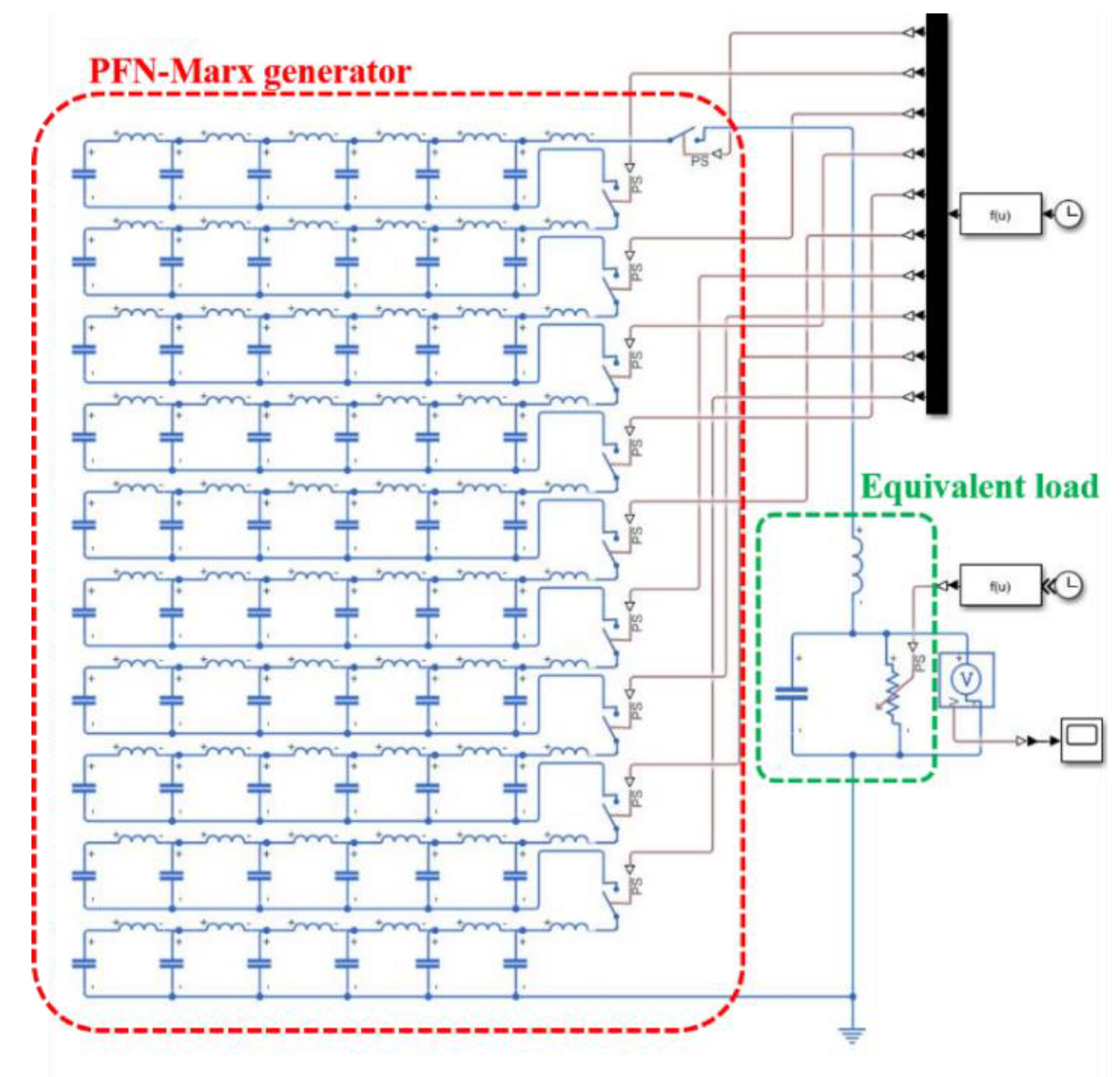
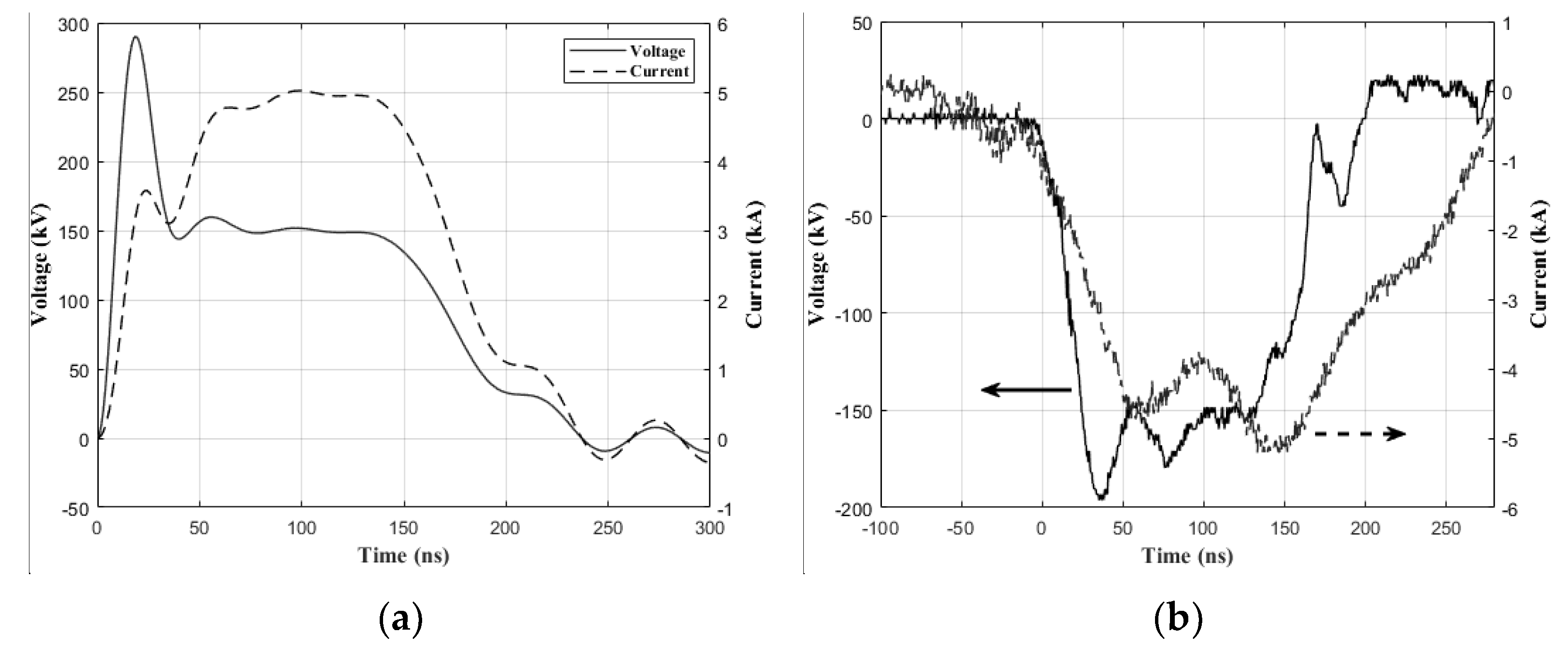
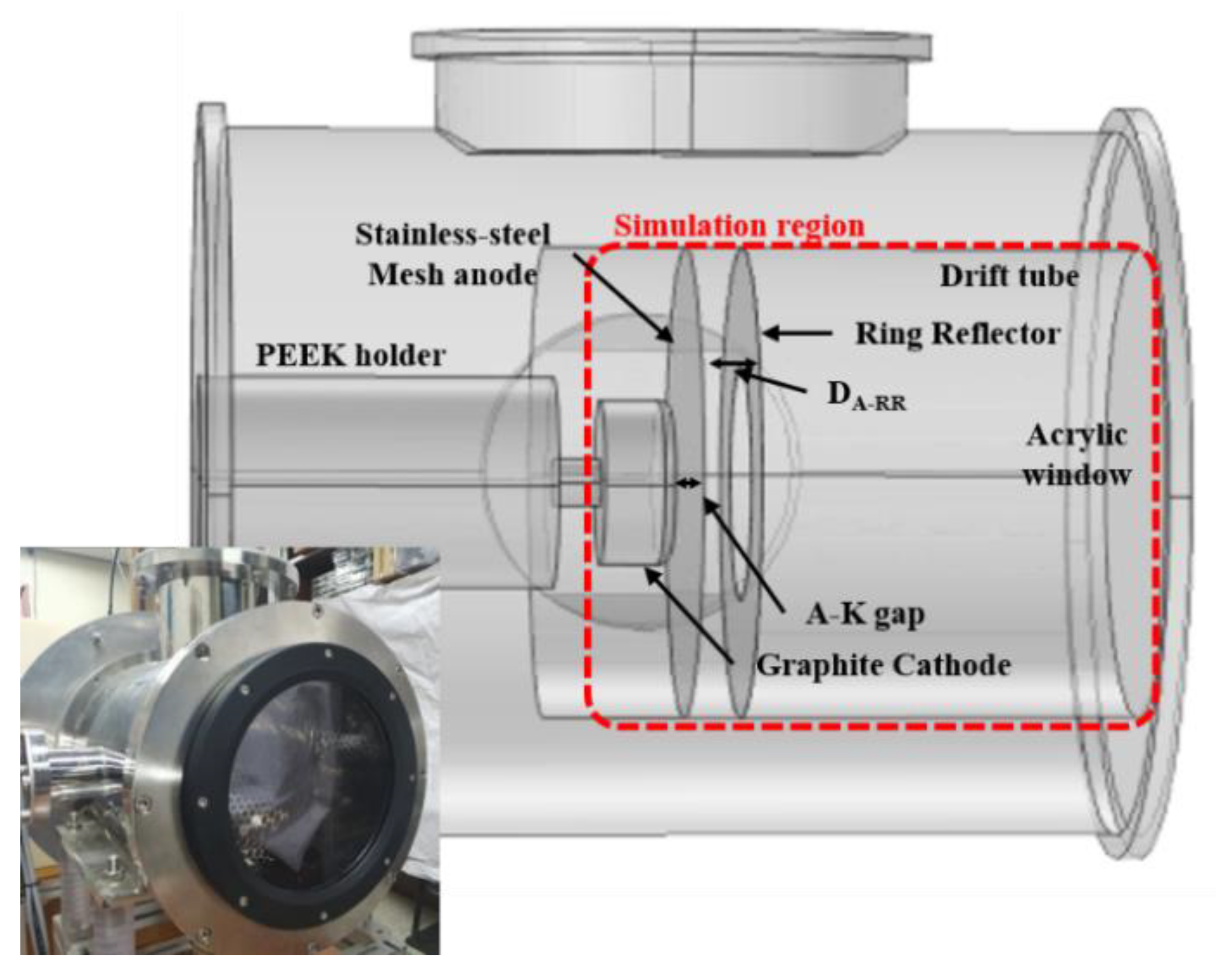
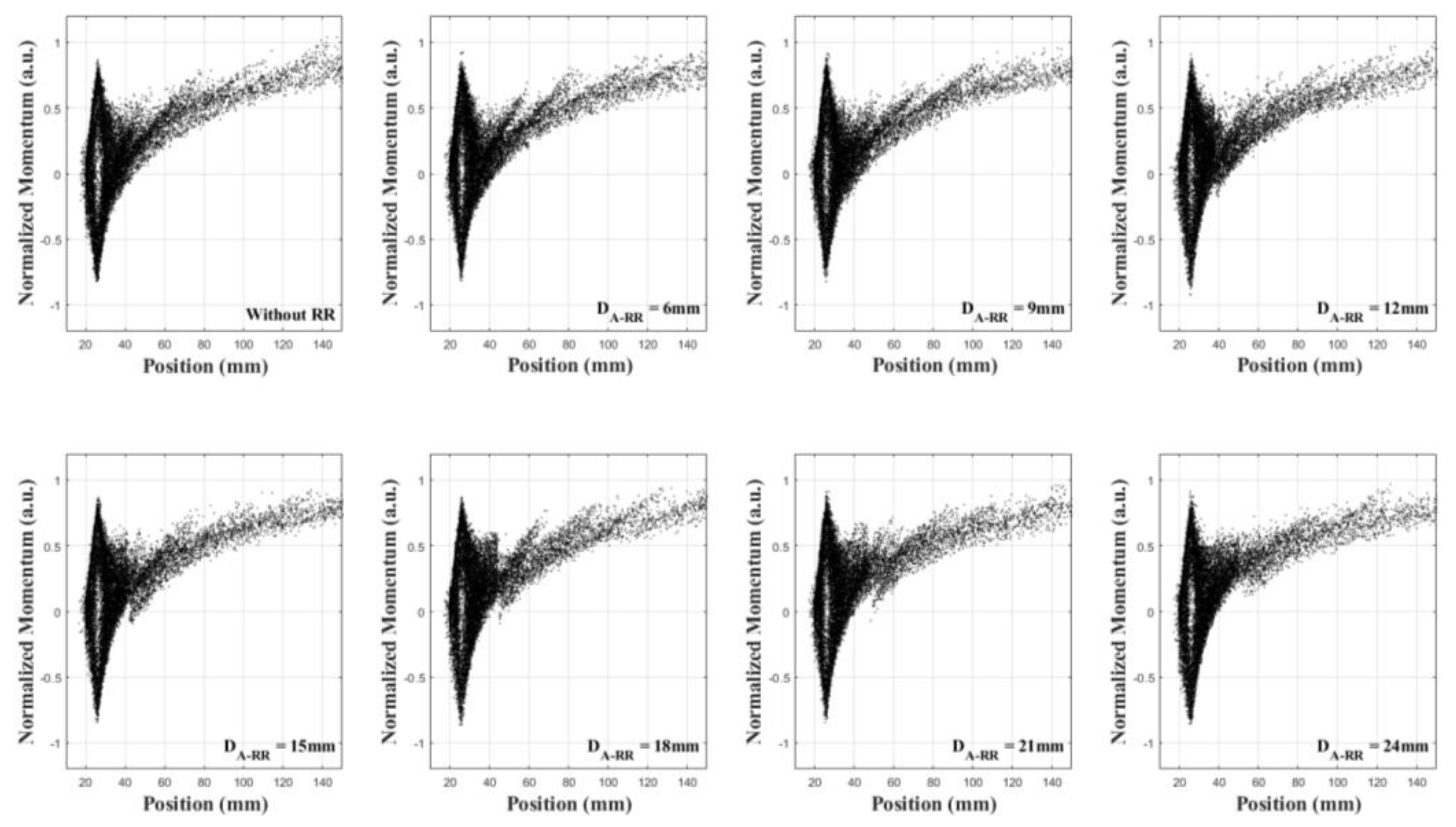
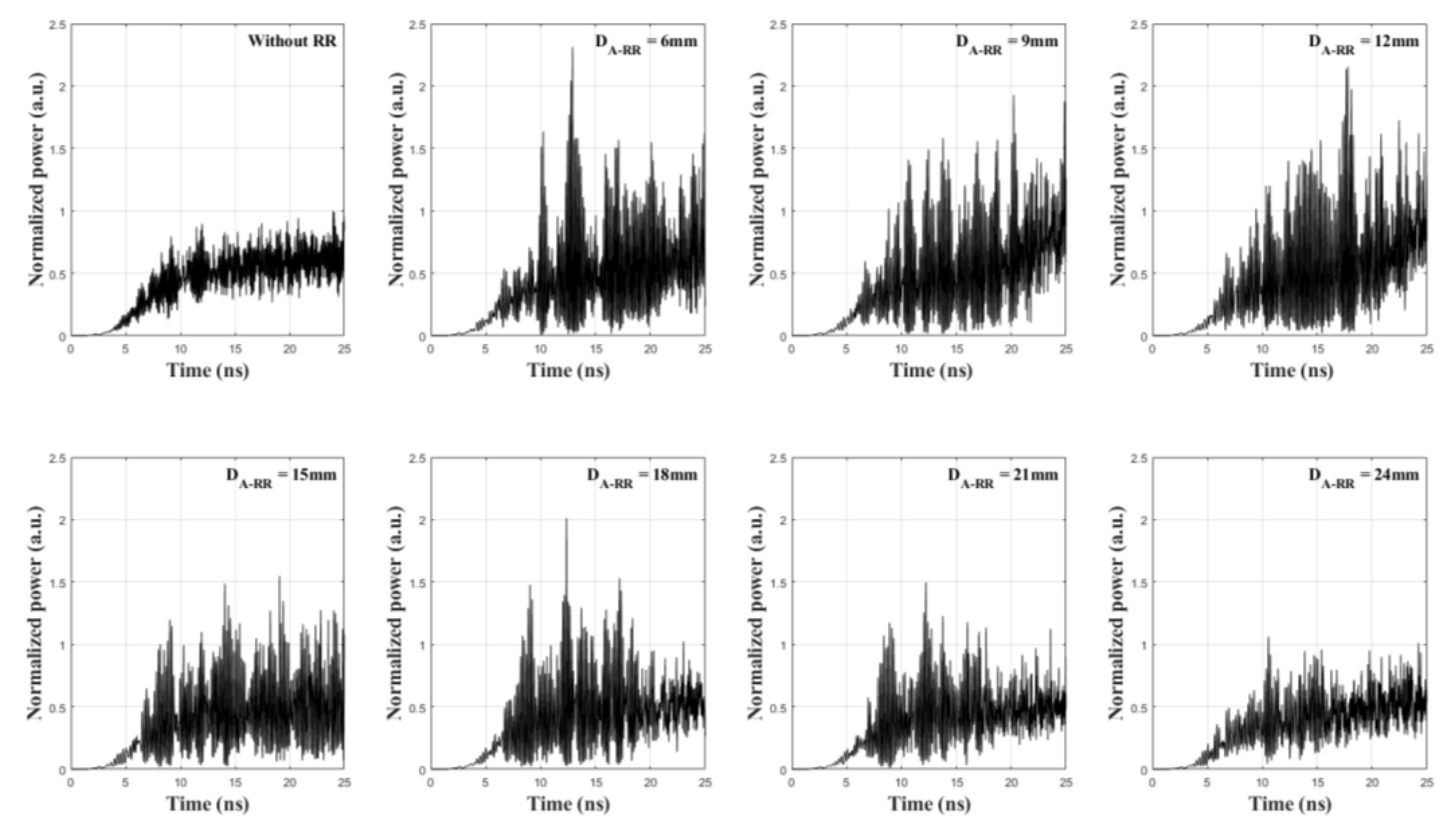

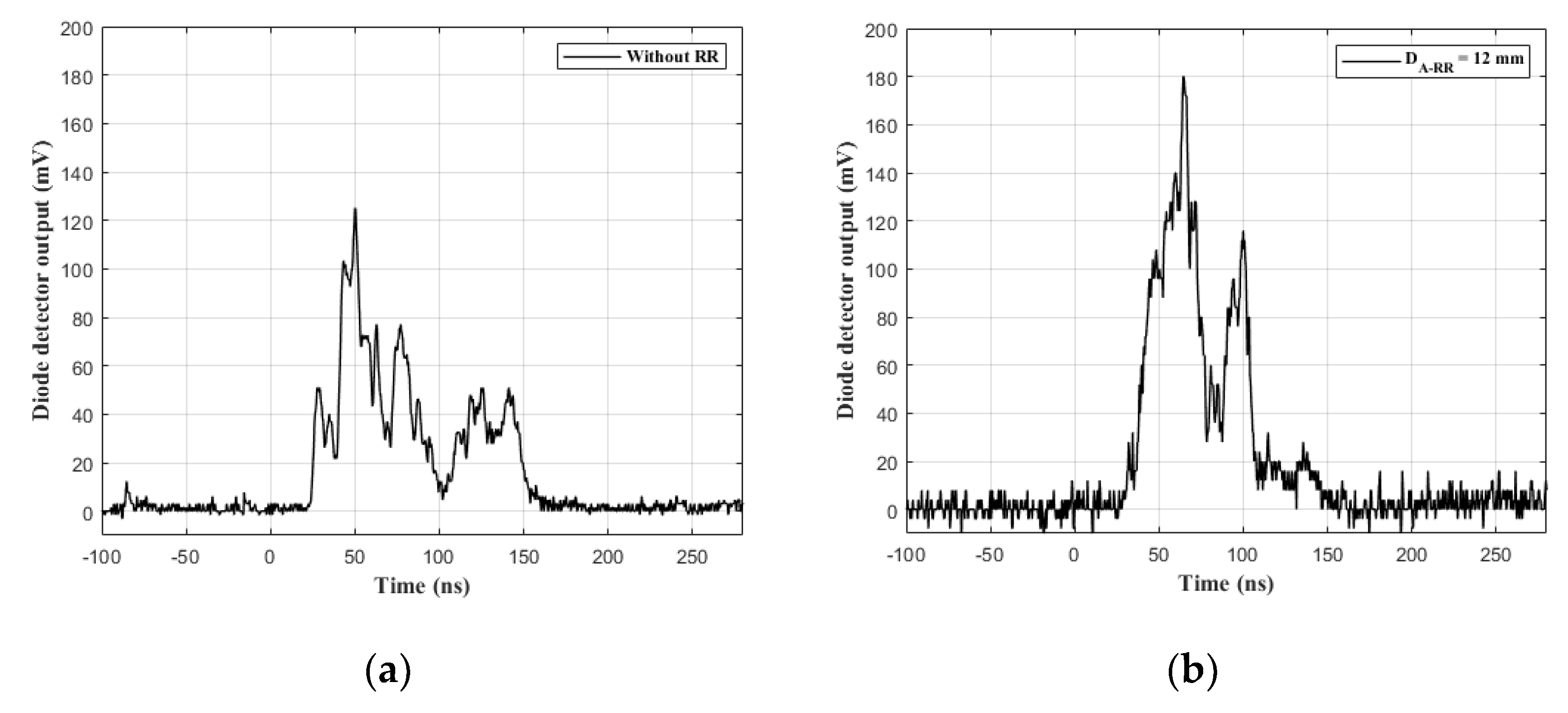
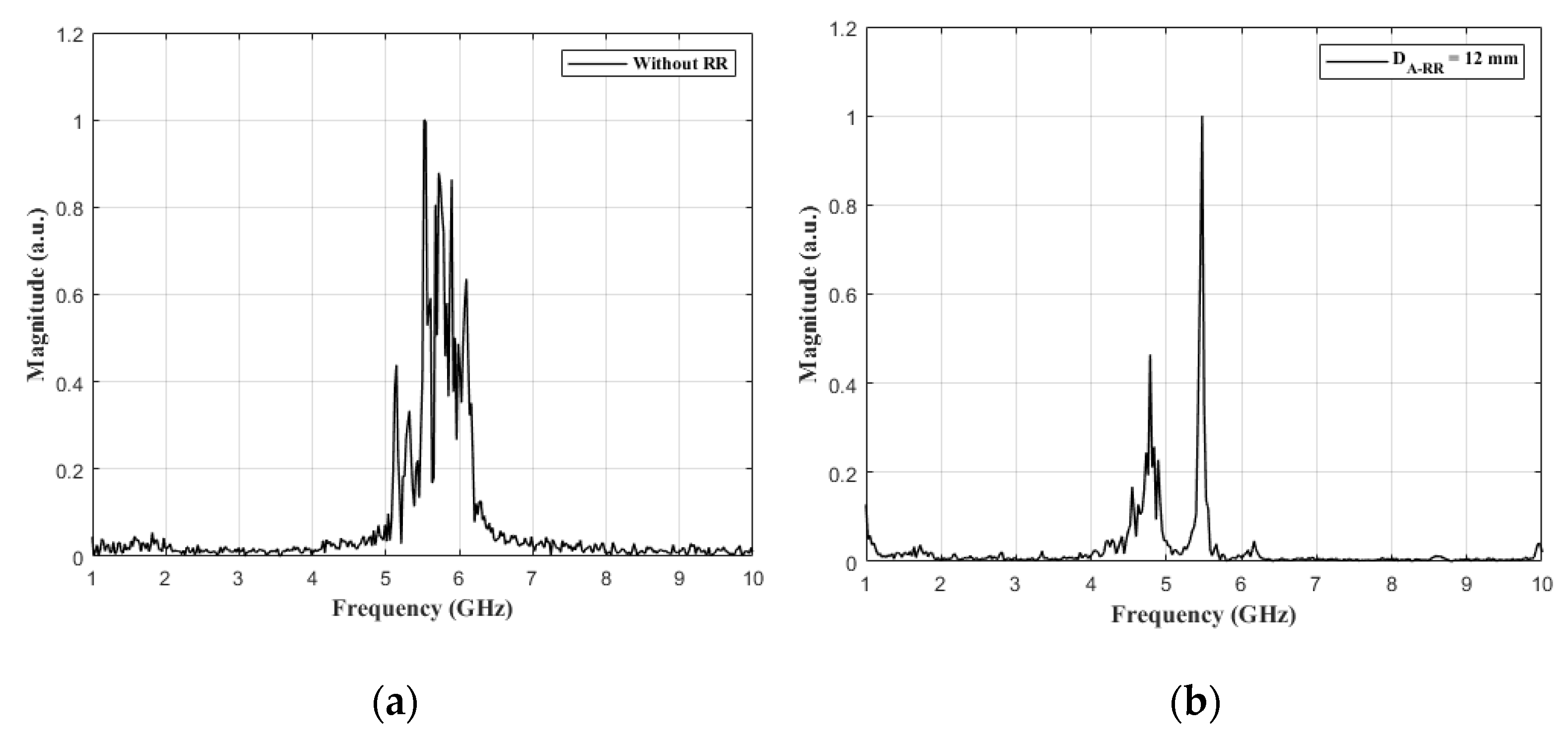

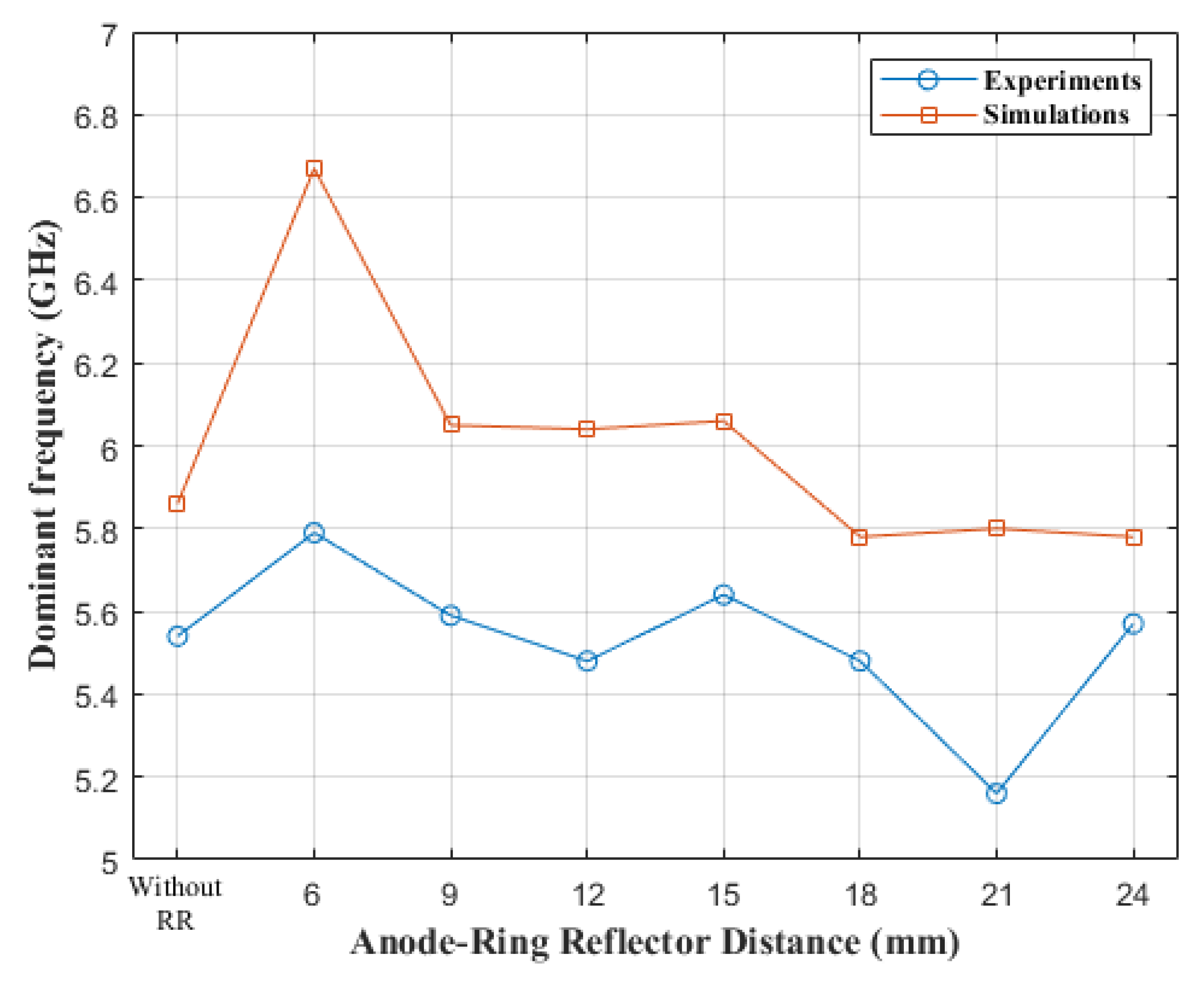
| Parameter | Value | Parameter | Value |
|---|---|---|---|
| Capacitance | 4.17 nF | Inductance | 37.5 nH |
| PFN stage | 6 | Marx stage | 10 |
| Charging voltage | −30 kV | Erected voltage | −300 kV |
| Pulse width | 150 ns | Characteristic impedance | 30 Ω |
| DA-RR | Pmin (MW) | Pmax (MW) | Pavg (MW) | Frequency (GHz) |
|---|---|---|---|---|
| Without RR | 8.7 | 12.3 | 11.22 | 5.54 |
| 6 mm | 18.11 | 25 | 22.79 | 5.79 |
| 9 mm | 19.36 | 24.43 | 21.53 | 5.59 |
| 12 mm | 15.14 | 22.75 | 20.99 | 5.48 |
| 15 mm | 16.22 | 18.62 | 18.28 | 5.64 |
| 18 mm | 24.38 | 29.31 | 25.82 | 5.48 |
| 21 mm | 12.53 | 16.2 | 15.35 | 5.16 |
| 24 mm | 11.22 | 13.27 | 12.42 | 5.57 |
Publisher’s Note: MDPI stays neutral with regard to jurisdictional claims in published maps and institutional affiliations. |
© 2021 by the authors. Licensee MDPI, Basel, Switzerland. This article is an open access article distributed under the terms and conditions of the Creative Commons Attribution (CC BY) license (https://creativecommons.org/licenses/by/4.0/).
Share and Cite
Kim, S.-H.; Lee, C.-J.; Kim, W.-I.; Ko, K.-C. Experimental Investigation into the Optimum Position of a Ring Reflector for an Axial Virtual Cathode Oscillator. Electronics 2021, 10, 1878. https://doi.org/10.3390/electronics10161878
Kim S-H, Lee C-J, Kim W-I, Ko K-C. Experimental Investigation into the Optimum Position of a Ring Reflector for an Axial Virtual Cathode Oscillator. Electronics. 2021; 10(16):1878. https://doi.org/10.3390/electronics10161878
Chicago/Turabian StyleKim, Se-Hoon, Chang-Jin Lee, Wan-Il Kim, and Kwang-Cheol Ko. 2021. "Experimental Investigation into the Optimum Position of a Ring Reflector for an Axial Virtual Cathode Oscillator" Electronics 10, no. 16: 1878. https://doi.org/10.3390/electronics10161878
APA StyleKim, S.-H., Lee, C.-J., Kim, W.-I., & Ko, K.-C. (2021). Experimental Investigation into the Optimum Position of a Ring Reflector for an Axial Virtual Cathode Oscillator. Electronics, 10(16), 1878. https://doi.org/10.3390/electronics10161878







